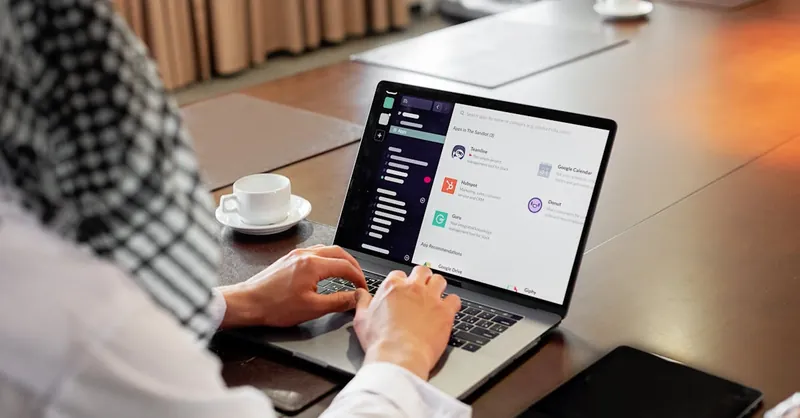Top AI Apps for Productivity to Boost Your Workflow
Category: Productivity & Automation
Unleash Your Productivity Potential with AI
If you're a professional, entrepreneur, or tech enthusiast here searching for the best AI apps for productivity, you already know that streamlining your daily tasks is crucial for success. Finding the right tools to automate repetitive work, manage projects efficiently, and leverage intelligent insights can mean the difference between constant overwhelm and focused accomplishment. Yet, with the growing ocean of AI-powered apps available, pinpointing those that truly deliver impactful results is overwhelming. This guide zeroes in on the top AI productivity apps tailored for users who demand more than just buzzwords—they want practical solutions that integrate seamlessly into their workflows.
You’ve likely tried various productivity tools before but found them lacking in either customization, AI sophistication, or ease of use. Perhaps you’re exploring automation options to save time without sacrificing quality, or seeking better ways to manage your projects using intelligent assistants. Our comprehensive breakdown dives deep into app features, user benefits, and the unique value each brings to boost your personal and professional productivity. We don’t just list apps; we help you understand which align with your specific needs and how to harness their full potential.
This post stands apart by focusing strictly on AI applications proven to optimize productivity through automation, smart task management, and technology integration. By the end, you’ll be equipped to choose the best AI tools tailored for your workflow and unlock new efficiencies you never thought possible.
- Unleash Your Productivity Potential with AI
- Understanding AI’s Impact on Productivity
- Criteria for Choosing the Best AI Productivity Apps
- AI-Powered Task and Project Management Apps
- Intelligent Scheduling and Calendar Assistants
- Automation Tools for Repetitive Tasks
- AI Writing and Content Generation Apps
- Note-Taking and Knowledge Management AI Apps
- Communication and Collaboration AI Solutions
- Security and Privacy Considerations When Using AI Productivity Apps
- Future Trends in AI Productivity Tools: Innovations Shaping Tomorrow’s Workflow
Understanding AI’s Impact on Productivity
Artificial Intelligence is revolutionizing productivity by transforming how we manage tasks, automate workflows, and make decisions. At its core, AI enhances efficiency by taking over repetitive and time-consuming activities, allowing professionals to focus on higher-value work. Smart task management tools powered by AI can prioritize your to-do list dynamically, adapt to changing schedules, and even predict deadlines you might overlook, ensuring nothing falls through the cracks. Meanwhile, workflow automation streamlines complex processes by integrating multiple apps and systems, reducing manual input, and accelerating project completion.
Beyond task handling, AI fundamentally improves decision-making through data-driven insights and predictive analytics. With AI algorithms analyzing historical trends and current data trends, you gain clearer visibility into project risks, resource allocation, and optimal next steps. This combination of automated efficiency and intelligent guidance elevates productivity from mere speed to strategic effectiveness — enabling professionals to work smarter, not harder. Embracing AI tools in your daily routine means investing in proven technologies that optimize time management, minimize errors, and unlock new levels of operational excellence.

Image courtesy of Ivan Samkov
Criteria for Choosing the Best AI Productivity Apps
Selecting the right AI productivity apps for daily professional use hinges on several key criteria that ensure these tools truly enhance efficiency without adding complexity. First and foremost, an app must offer robust AI capabilities—such as intelligent automation, accurate natural language processing, or smart scheduling—that go beyond basic features to actively reduce manual workload. Equally important is seamless integration with your existing tools and platforms, including calendars, email, project management software, and cloud storage. This interoperability keeps your workflows uninterrupted and centralizes information access, a critical factor for sustained productivity gains.
Beyond functionality, consider the user experience (UX) and interface design. AI apps should be intuitive and customizable, allowing users of varying tech comfort levels to quickly adopt and tailor the tool to their unique processes. Features like real-time collaboration, clear notifications, and adaptive learning curves enhance daily use without causing friction or cognitive overload. Lastly, pay attention to security and privacy standards, especially for AI tools that analyze sensitive data or communicate across networks. Choosing apps that balance advanced AI performance with user-friendly design and strong integrations will position you to maximize productivity gains and drive consistent results in your professional environment.

Image courtesy of Mikhail Nilov
AI-Powered Task and Project Management Apps
When it comes to managing complex projects and balancing competing priorities, AI-powered task and project management apps are game-changers for boosting productivity. These tools leverage machine learning, natural language processing, and predictive analytics to organize, prioritize, and automate project workflows with unprecedented efficiency. Unlike traditional task managers, AI-driven apps dynamically adjust to your habits, project deadlines, and team inputs, helping you stay focused on what truly matters.
Top AI task managers offer capabilities such as:
- Smart Task Prioritization – AI algorithms analyze deadlines, dependencies, and workload to automatically rank tasks by urgency and impact, allowing you to tackle high-value work first.
- Automated Workflow Optimization – By connecting different stages of your projects and integrating with other software, these apps reduce manual handoffs and repetitive updates through intelligent automation.
- Resource Allocation Insights – AI evaluates team capacity and project requirements to suggest optimal task assignments, minimizing bottlenecks and preventing burnout.
- Natural Language Input – Many apps allow you to create and update tasks using conversational commands, speeding up project updates without interrupting your flow.
Some standout AI-powered project management platforms include ClickUp, Asana with AI integrations, and Monday.com, all designed to keep projects moving smoothly by enhancing collaboration, visibility, and real-time decision-making. By embedding AI directly into task and project workflows, these tools liberate you from micromanagement and manual tracking, enabling more strategic focus and faster, smarter project delivery.
Incorporating AI-based task and project management apps into your productivity stack not only maximizes workflow efficiency but also empowers teams to adapt quickly to changing priorities—an essential advantage in today’s fast-paced professional environments.

Image courtesy of ANTONI SHKRABA production
Intelligent Scheduling and Calendar Assistants
Efficient time management is the backbone of productivity, and AI-powered scheduling and calendar assistants are transforming how professionals plan their days. These intelligent tools go beyond traditional calendars by automating meeting scheduling, optimizing agenda management, and sending proactive reminders, ensuring that your valuable time is allocated with maximum impact. By leveraging natural language processing and machine learning, these apps understand your preferences, availability, and priorities to suggest optimal meeting times, avoid conflicts, and minimize the back-and-forth emails often associated with coordinating schedules.
Key features that make AI scheduling assistants indispensable include:
- Smart Meeting Coordination – AI scans all participants’ calendars to identify ideal time slots, automatically handling rescheduling and cancellations without manual input.
- Context-Aware Reminders – More than just alerts, these assistants provide timely, personalized nudges based on meeting importance, prep time needed, and location changes.
- Dynamic Daily Agenda Optimization – Some tools analyze your workload and meeting density to suggest breaks or task windows, helping combat scheduling fatigue and maintain focus.
- Integration with Communication Platforms – Seamless syncing with email, messaging apps, and video conferencing ensures effortless joining of meetings and streamlines communication workflows.
Popular AI scheduling apps like Calendly, x.ai, and Microsoft Cortana Calendar combine ease of use with powerful AI engines to reduce scheduling friction and keep your day on track. By automating calendar management, these intelligent assistants free you from the administrative burden of organizing meetings, empowering you to invest more time in meaningful work. Incorporating AI-driven scheduling into your productivity toolkit is essential for professionals who want to maximize every minute and maintain a well-structured, stress-free agenda.

Image courtesy of RDNE Stock project
Automation Tools for Repetitive Tasks
One of the most significant productivity boosts comes from AI-driven automation platforms that handle routine, repetitive tasks seamlessly—freeing up your time to focus on high-impact activities. These automation tools excel at connecting various apps and services through intelligent workflows that eliminate manual data entry, email sorting, file organization, and other time-consuming operations. By leveraging AI’s ability to understand context and predict user intent, these platforms not only execute pre-defined rules but can also adapt workflows based on changing conditions, ensuring continuous optimization.
Key benefits of using AI automation tools include:
- Time Savings – Automate mundane tasks such as data transfer, report generation, and client follow-ups to reduce busywork significantly.
- Error Reduction – Minimize human mistakes in repetitive processes by letting AI handle consistent, rule-based operations with precision.
- Cross-App Integration – Connect disparate tools like CRM systems, email platforms, cloud storage, and collaboration apps to create unified workflows that enhance overall efficiency.
- Scalability – Scale repetitive operations without additional manual effort, making these tools ideal for growing teams and enterprises requiring consistent business processes.
Prominent AI-powered automation platforms like Zapier, Integromat (Make), and Microsoft Power Automate enable users to craft customized workflows with ease, supported by AI algorithms that suggest workflow improvements and error handling. These tools democratize automation by reducing technical barriers—any professional can implement automation to smooth daily operations. Incorporating these AI automation platforms into your productivity toolkit maximizes efficiency, accelerates process completion, and transforms how routine work gets done in any professional setting.

Image courtesy of Kindel Media
AI Writing and Content Generation Apps
In today’s fast-paced work environment, producing high-quality written content quickly is essential for maintaining productivity and staying competitive. AI writing and content generation apps are transforming how professionals draft, edit, and brainstorm ideas by leveraging advanced natural language processing (NLP) and machine learning technologies. These tools help eliminate writer’s block, accelerate content creation, and ensure clarity and coherence—saving valuable time throughout the writing process.
Top AI writing apps offer a range of features designed to boost productivity:
- Automated Drafting – Generate initial content outlines, blog posts, emails, or reports based on simple prompts, reducing the time spent starting from scratch.
- Real-Time Editing and Suggestions – Receive grammar, style, tone, and clarity improvements as you write, enabling polished output without lengthy revisions.
- Idea Brainstorming and Expansion – Use AI to generate creative ideas, rephrase text, or expand bullet points into detailed paragraphs, aiding faster content development.
- Multilingual Support – Many tools support multiple languages and translation capabilities, allowing seamless communication with global audiences.
- SEO Optimization Assistance – Some AI writing apps suggest keywords, headings, and meta descriptions tailored to improve search engine rankings and online visibility.
Leading AI writing platforms like Grammarly, Jasper AI, and Copy.ai empower professionals, marketers, and content creators by streamlining text production and increasing accuracy. By integrating these AI writing assistants into your workflow, you can drastically reduce time spent on drafting and editing, while enhancing the overall quality and consistency of your material. Whether you’re composing emails, reports, or creative content, AI writing apps are indispensable productivity boosters that help you communicate more efficiently and effectively.

Image courtesy of SHVETS production
Note-Taking and Knowledge Management AI Apps
In the quest for heightened productivity, note-taking and knowledge management AI apps play a pivotal role by transforming how professionals capture, organize, and retrieve information. These intelligent tools leverage advanced AI algorithms such as natural language processing (NLP) and machine learning to convert raw data—notes, documents, web clippings—into structured, searchable knowledge bases. By automating categorization, summarization, and contextual linking, these apps dramatically improve recall accuracy and reduce time wasted sifting through unorganized resources.
Key advantages of AI-driven note-taking and knowledge management solutions include:
- Automated Content Organization – AI tags and categorizes notes intelligently, grouping related concepts and documents without manual sorting.
- Enhanced Recall through Semantic Search – Unlike simple keyword searches, AI systems understand context and synonyms to surface relevant knowledge quickly, even from scattered data sources.
- Smart Summarization and Highlights – Automatically generate concise summaries and highlight critical insights within large documents or meeting transcripts.
- Contextual Linking and Knowledge Graphs – Establish dynamic relationships between notes and topics, creating a personalized knowledge web that evolves with your projects.
- Cross-Platform Synchronization – Seamless syncing across devices and integrations with other productivity apps ensures your knowledge is accessible anywhere, anytime.
Leading AI note-taking apps like Notion AI, Mem, and Evernote with AI enhancements empower users to manage personal knowledge and professional research with unprecedented ease. By embedding AI into knowledge workflows, these tools not only boost information organization but also foster deeper insights and faster decision-making. For professionals who juggle complex projects, extensive research, or continuous learning, adopting AI-powered note-taking and knowledge management apps is essential for maintaining clarity, speed, and strategic advantage in an information-rich environment.

Image courtesy of freestocks.org
Communication and Collaboration AI Solutions
Seamless communication and collaboration are fundamental to productive teams, especially in today’s increasingly remote and hybrid work environments. AI-powered communication solutions are designed to enhance team interactions by reducing misunderstandings, streamlining information flow, and fostering real-time connectivity regardless of location. By integrating natural language processing (NLP), sentiment analysis, and intelligent automation, these AI tools break down communication barriers and promote more effective teamwork.
Key advantages of AI communication and collaboration apps include:
- Contextual Understanding and Summarization – AI algorithms digest lengthy email threads, chat conversations, or meeting transcripts to generate concise summaries, enabling team members to quickly grasp key points and action items without information overload.
- Real-Time Language Translation and Transcription – These features help global teams communicate effortlessly by providing instant translations and converting voice meetings into searchable text, removing language-related delays.
- Smart Meeting Assistants – AI-driven virtual assistants can schedule meetings based on team availability, propose agendas, record discussions, and automatically assign follow-up tasks to responsible members, ensuring accountability and progress.
- Sentiment and Engagement Analysis – By analyzing communication tone and engagement levels across channels, AI tools help managers detect potential conflicts or disengagement early, fostering a healthier team dynamic.
- Collaborative Document Editing with AI Suggestions – Real-time co-editing supported by AI improves clarity, flags inconsistencies, and offers content enhancement suggestions, accelerating the document review process.
Leading AI-powered communication platforms such as Slack with AI integrations, Microsoft Teams with Cortana, and Otter.ai empower teams to stay aligned, reduce miscommunication, and boost overall productivity. By leveraging AI to enhance how people share information and collaborate, these tools enable organizations to maintain momentum and deliver outcomes faster, even in complex, distributed workflows. Integrating AI communication solutions is an essential step for professionals and teams striving to elevate remote work effectiveness and achieve smoother, more intelligent collaboration.

Image courtesy of RDNE Stock project
Security and Privacy Considerations When Using AI Productivity Apps
As AI productivity apps increasingly handle sensitive data—ranging from personal schedules to proprietary business information—security and privacy become critical factors in choosing and using these tools effectively. While AI can dramatically enhance efficiency, it also raises concerns about data protection, unauthorized access, and compliance with privacy regulations. To maximize the benefits of AI productivity apps without compromising your data security, it is essential to follow best practices and be aware of underlying risks.
Key Best Practices to Protect Your Data
-
Choose Apps with Strong Data Encryption
Ensure that AI productivity applications use robust encryption protocols for data both in transit and at rest. This mitigates the risk of interception or unauthorized data access, especially when syncing data across devices or cloud platforms. -
Review Privacy Policies and Data Handling Practices
Before integrating any AI tool, carefully examine their privacy policies to understand how your data is collected, stored, and shared. Favor applications that commit to minimal data retention and do not monetize user data without explicit consent. -
Implement Role-Based Access Controls and Authentication
Secure your AI apps by enabling multi-factor authentication (MFA) and setting precise user permissions. This limits data exposure within teams and protects sensitive information from potential breaches or internal misuse. -
Stay Updated on Regulatory Compliance
Use AI productivity apps that comply with relevant data protection regulations such as GDPR, CCPA, or HIPAA (for healthcare-related information). Compliance ensures that the app providers follow stringent standards in managing user data securely and transparently. -
Leverage On-Premises or Private Cloud Options When Possible
For highly sensitive environments, consider AI solutions offering on-premises deployment or private cloud storage, giving you greater control over your data environment and reducing reliance on third-party servers. -
Regularly Audit and Monitor Data Usage
Continuously track how data flows within AI tools and integrate audit logs to detect unusual behavior promptly. Early detection of anomalies can prevent potential leaks or unauthorized data transfers.
By prioritizing these security and privacy practices, professionals can confidently adopt AI productivity apps and harness their full capabilities without exposing themselves or their organizations to unnecessary risks. This balance between innovation and protection is fundamental for sustaining trust and achieving long-term productivity gains in a digitally connected world.

Image courtesy of Antoni Shkraba Studio
Future Trends in AI Productivity Tools: Innovations Shaping Tomorrow’s Workflow
The landscape of AI productivity apps is evolving rapidly, driven by groundbreaking technologies and innovative approaches that promise to redefine how we work. As artificial intelligence advances, next-generation productivity tools are becoming increasingly intuitive, adaptive, and deeply integrated into all facets of professional life. Key trends shaping the future of AI-enhanced productivity include:
-
Hyper-Personalized AI Assistants
Future AI apps will leverage advanced machine learning and behavioral analytics to deliver extremely personalized task management, scheduling, and workflow recommendations. These assistants won’t just react to commands but will proactively anticipate needs by understanding individual work styles, habits, and priorities—resulting in highly customized productivity optimization. -
Contextual and Multimodal AI Interaction
Emerging tools will combine voice, text, and visual inputs seamlessly, allowing users to interact with AI through natural conversations, gestures, or visual cues. This multimodal approach makes productivity apps more accessible, reduces friction, and enables faster execution of complex tasks in diverse environments. -
AI-Driven Predictive Analytics and Decision Support
By harnessing vast datasets and real-time inputs, future AI productivity platforms will offer deeper predictive insights—such as project risk forecasts, resource bottleneck detection, and dynamic workload balancing—empowering professionals to make smarter, data-backed decisions before challenges arise. -
Integration of AI with Augmented Reality (AR) and Virtual Reality (VR)
Productivity apps embedded in AR/VR environments will transform collaboration and task execution by providing immersive, interactive digital workspaces. These innovations will facilitate real-time brainstorming, virtual teamwork, and enhanced focus through spatial computing interfaces powered by AI. -
Ethical AI and Transparency as a Standard
As AI tools become more pervasive, future developments will emphasize explainability and ethical AI use, ensuring users understand how decisions are made and preserving privacy without sacrificing productivity gains. -
Expansion of Autonomous Workflows
AI will increasingly handle entire end-to-end workflows autonomously—beyond automating repetitive tasks—to dynamically managing complex projects, coordinating teams, and even handling client communications with minimal human intervention.
Embracing these future trends in AI productivity tools will be essential for professionals and organizations aiming to stay competitive in an ever-accelerating digital economy. Staying informed about such innovations enables early adoption of cutting-edge applications that not only enhance productivity but also drive transformative changes across industries. By integrating evolving AI capabilities, you position yourself at the forefront of smarter, faster, and more adaptive workflows primed for the future.

Image courtesy of Matheus Bertelli
